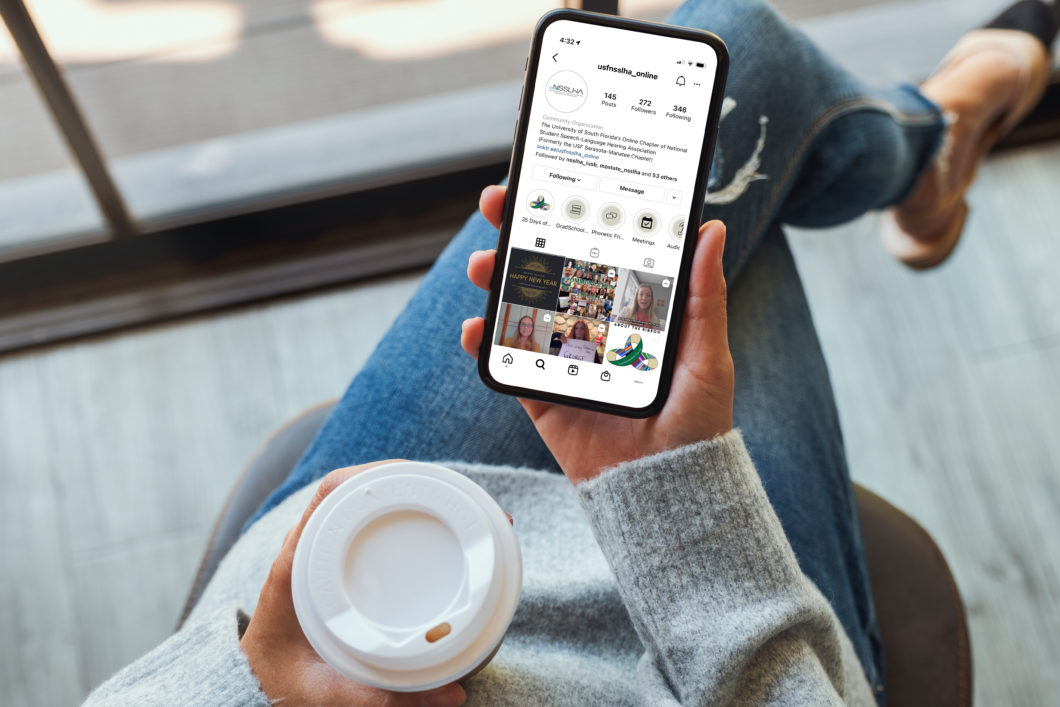While the rest of the country has been faced with the challenge of going virtual this year, “virtual” is nothing new for our online undergraduate program at the University of South Florida Sarasota-Manatee Campus. As the historian of our NSSLHA chapter, I’ve implemented strategies on our social media platforms to increase engagement within our organization. Of the many wonderful things social media can do for a virtual chapter, we’ve found that building a community and sharing content in creative ways are among the most important.
Connecting Our Community
As an entirely online program even prior to the pandemic, our campus has students who are located across cities, states, and even countries. Maintaining a sense of community within a group so physically far apart can be difficult; however, social media has been a great platform to help bridge that gap. We frequently use polls on our Instagram and Facebook stories to learn about our members and tailor our content to their needs. For instance, a large percentage of our members this year are seniors, so we’ve focused on finding and sharing resources pertinent to graduate school applications. We also make sure to brag about the accomplishments of our members and continue to support past students in their current endeavors.
We stay connected to the larger community by following and consistently sharing content from CSD-related pages and students/professionals in the discipline. We also recognize and share information about CSD-related awareness days and months. For example, many of our informative posts were audiology-focused in October in celebration of Audiology Awareness Month. Our use of social media has allowed us to better connect with one another, as well as the overall CSD community, regardless of our physical location.
Providing Content
Besides virtual meetings and events, our chapter utilizes social media as a way to creatively and consistently share further content with our members. During the Fall 2020 semester, we introduced guest takeovers on our social media accounts. Monthly, we invite graduate students or professionals in the discipline to answer our questions and show us a day in their life through our Instagram and Facebook stories. Through these takeovers, we’ve given students an incredibly realistic perspective of what their future may look like and provided information on how best to get there. Also, we implemented “Phonetics Friday”—where our faculty advisor posts weekly phonetics-related questions for our members to answer. Previous graduates of our program have said that phonetics is something they struggle with, even in graduate school, so Phonetics Friday gives students a fun way to refresh their memory every week. You can easily apply this idea to whatever subject is best suited for your chapter—and it can either be professor- or student-led.
Taking Advantage of Social Media Tools
- The most helpful tool I have found for creating social media graphics is the website Canva. It’s free, is very user-friendly, and offers thousands of templates to create Instagram posts and stories, Facebook posts, flyers, logos, etc.
- Because Instagram allows only one link in the profile’s bio, I use Linktree to hold any websites our members may need. This one link not only contains the direct websites to join National NSSLHA, our NSSLHA chapter, and our chapter’s social media platforms but also gives me the ability to add in the links to our virtual meetings, community outreach, or events as they become appropriate.
- Another time-saving tool I use regularly is a social media scheduler. Planoly is a free website/app that links to your page’s Instagram and allows you to schedule future posts to be uploaded whenever you choose. Facebook also has this feature built into your page. Before the start of each week, I take some time to create the graphics and captions for that week and schedule them to be uploaded to both Instagram and Facebook. Many free social media schedulers are available, so I recommend finding one you like to help save time throughout the week.
Helpful Tips for Your Chapter
- Post consistently! Posting regularly to your social media accounts creates a positive cycle of member engagement. I recommend making a content calendar where you determine how often a week you’d like to post and what kind of content you may post on which days. For example, we usually post three to five times per week, with graduate school information on Tuesdays and phonetics-related content on Fridays (Phonetics Friday).
- Promote yourself! Don’t forget to post frequently about upcoming meetings, events, fundraisers, and chapter activities. Make sure it’s clear that there are many ways your members can get involved and they can always check your social media platforms for the latest information.
- Make it pretty! At the beginning of the semester, I chose a color scheme with about six different colors that I primarily use in the graphics I make. Consistent colors look especially nice on Instagram and make your chapter look professional.
- Like and interact with your members and followers’ posts! Getting your whole board interacting with members over social media can help create the comfortable, friendly back-and-forth that may be lacking in a virtual environment.

